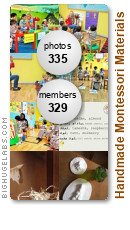Caring for Plants in the Classroom
I couldn't wait until Easter break to make a rick-rack apron for Tie One On. The rick-rack itself is understated, but the overall effect of the hand-appliqué and three dimensional flowers is awesome in person. Et voila! Thus was born the most nifty "watering flowers" apron this side of the Sierra Madre. You can make your own similar apron of any style. (This one is a bit complicated with the lining, pleats and all ... I can't even tell you how I did it ... it was pure luck.) All you will need is a bit of Pellon's Wonder Under (found at any fabric store) and this great tutorial for making the flowers, or "yo-yo's."
You can make your own similar apron of any style. (This one is a bit complicated with the lining, pleats and all ... I can't even tell you how I did it ... it was pure luck.) All you will need is a bit of Pellon's Wonder Under (found at any fabric store) and this great tutorial for making the flowers, or "yo-yo's."
Iron the Wonder Under to the back side of the fabric you want to appliqué, wait for it to cool, then draw the design for the watering can/pot/leaves. Cut out design, peel off the backing, and iron directly onto the main fabric. Then comes the time consuming part - hand stitch all around each appliqué, using a coordinating thread. I also added some french knots to mimic dripping water. The rick-rack was machine stitched after the rest of the embroidery was completed. This is (one of) the best parts about this apron - its loop to hold the watering indicators. In my classroom, we use two types of markers ... one that identifies a plant that needs watering (here it is the green with the blue embroidered drop,) and another (here the red flower) that tells the children that this plant has already been watered today. You need to have one of each for each plant in the environment. For example, if you have 10 plants, you would need 10 greens and 10 reds. The indicators that are not in use remain in a pretty vase on the practical life shelf next to the apron and watering can.
This is (one of) the best parts about this apron - its loop to hold the watering indicators. In my classroom, we use two types of markers ... one that identifies a plant that needs watering (here it is the green with the blue embroidered drop,) and another (here the red flower) that tells the children that this plant has already been watered today. You need to have one of each for each plant in the environment. For example, if you have 10 plants, you would need 10 greens and 10 reds. The indicators that are not in use remain in a pretty vase on the practical life shelf next to the apron and watering can. In the morning, the guide checks the humidity of the soil in each plant and (most likely) places a green, "water me" indicator in the pot. During the day, the child that chooses to water plants puts on the apron and inserts several red "I've been watered" indicators in the apron loop. The child's hands are then free to carry the watering can.
In the morning, the guide checks the humidity of the soil in each plant and (most likely) places a green, "water me" indicator in the pot. During the day, the child that chooses to water plants puts on the apron and inserts several red "I've been watered" indicators in the apron loop. The child's hands are then free to carry the watering can. The child removes the green indicator, wipes off the soil with a small towel, (I'll explain this later) and places it in the loop before watering the plant. After the plant has been watered, she places the red indicator in the soil. She continues in this manner until she has used up her stash of red indicators, at which time she can place the green indicators from her apron loop in the pretty vase. If there are more red indicators left in the vase, she can repeat the process. If not, work for that day is complete, as all of the plants have been watered.
The child removes the green indicator, wipes off the soil with a small towel, (I'll explain this later) and places it in the loop before watering the plant. After the plant has been watered, she places the red indicator in the soil. She continues in this manner until she has used up her stash of red indicators, at which time she can place the green indicators from her apron loop in the pretty vase. If there are more red indicators left in the vase, she can repeat the process. If not, work for that day is complete, as all of the plants have been watered. During the presentation, I would show the child that the small (3inx3in) towel that is placed under the watering can spout to prevent dripping is also used to wipe off any soil from the indicator before placing it in the apron loop.
During the presentation, I would show the child that the small (3inx3in) towel that is placed under the watering can spout to prevent dripping is also used to wipe off any soil from the indicator before placing it in the apron loop.
Here are a few more ideas concerning plants in the environment:
1.) Why not label the classroom and garden plants and have this as a classified reading exercise? This could also be done at home in the garden and with potted plants.
2.) Have another material for dusting plant leaves. This might use the same apron as the watering exercise, with a tiny spray bottle/mister (why not use an antique perfume bottle?) and a 3cm x 3cm piece of felt. The presentation is simple - mist a leaf, gently wipe off the dust with the felt.
3.) Another plant care extension is a presentation on how to remove and compost dry, dead plant leaves. The only material required is a small basket in which to place the leaves to transport them to the compost.
4.) Check out the North American Montessori Teacher's Association's (NAMTA) video on the Child in Nature - I have not had the opportunity to see it, but it is highly recommended by my colleague, who says it is an incredible look at how one can set up the outdoor component to the Montessori classroom.
5.) Try to find artistic representations of every plant you have in the environment (e.g. post cards of paintings, collage, pencil drawings, tapestries, fiber art,) and have the children match the art with the real plant.
6.) And an idea from Maria Montessori herself, as found in the Clio series of "The Discovery of the Child," page 75:
"Little pots of fragrant plants can also have a practical interest. A child's activity then consists in searching for, distinguishing, and gathering the plants with different scents. An exercise in distinguishing things that look alike and in seeking out a scent rather than a flower is exacting and affords the satisfaction of discovery."
(Think of having mints and herbs in the environment!)
I'll close this post with some more of Montessori's own words, again from that same chapter in The Discovery of the Child:
"The children never forgot to water the plants with a little watering can. One morning I found them all seated in a circle on the floor around a magnificent red rose that had opened up during the night. They were silent and peaceful, completely absorbed in contemplation."











No comments:
Post a Comment